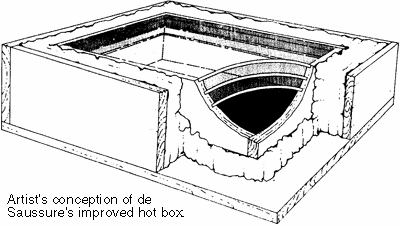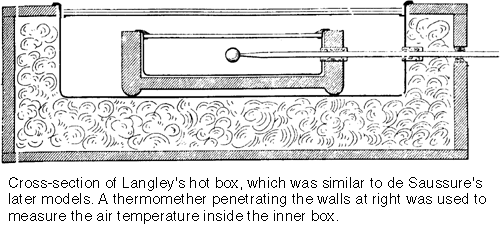horace de saussure and his hot boxes of the 1700's
 the increased use of glass during the eighteenth
century made many people aware of its ability to trap solar heat. as horace de
saussure,
one of europe’s foremost naturalists of the period, observed: "it is a known
fact, and a fact that has probably been known for a long time, that a room, a carriage, or
any other place is hotter when the rays of the sun pass through glass." this
french-swiss scientist was quite surprised that such a common phenomenon had not led to
any empirical research on the maximum temperature attainable in a glass solar heat trap.
when experimenting with solar energy, his contemporaries preferred to work with burning
mirrors, which could perform such amazing feats as burning objects at a distance or
melting the hardest metals within seconds. in 1767, de saussure set out to determine how
effectively glass heat traps could collect the energy of the sun.
the increased use of glass during the eighteenth
century made many people aware of its ability to trap solar heat. as horace de
saussure,
one of europe’s foremost naturalists of the period, observed: "it is a known
fact, and a fact that has probably been known for a long time, that a room, a carriage, or
any other place is hotter when the rays of the sun pass through glass." this
french-swiss scientist was quite surprised that such a common phenomenon had not led to
any empirical research on the maximum temperature attainable in a glass solar heat trap.
when experimenting with solar energy, his contemporaries preferred to work with burning
mirrors, which could perform such amazing feats as burning objects at a distance or
melting the hardest metals within seconds. in 1767, de saussure set out to determine how
effectively glass heat traps could collect the energy of the sun.
de saussure first built a miniature greenhouse five walls thick. he constructed it from five square boxes of glass, decreasing in size from 12 in. on a side by 6 in. high to 4 in. on a side by 2 in. high. the bases of the boxes were cut out so the five boxes could be stacked one inside the other atop a black wooden table. after exposing the apparatus to the sun for several hours, and rotating the model so that solar rays always struck the glass covers of the boxes perpendicularly, de saussure measured the temperature inside. the outermost box was the coolest, and the temperature increased in each succeeding smaller box. the bottom of the innermost box registered the highest temperature—189.5� f. "fruits. . . exposed to this heat were cooked and became juicy," he wrote.
de saussure seemed unsure of how the sun heated the glass boxes:
physicists are not unanimous as to the nature of sunlight. some regard it as the same element as fire, but in the state of its greatest purity. others envisage it as an entity with a nature completely different from fire, and which, incapable of itself heating, has only the power to give an igneous fluid the movement which produces heat.
despite de saussure’s shaky theoretical underpinnings, the validity of his test results is beyond question.
today we can better explain what went on in de saussure’s glass boxes or what will occur in any glass container or glass-walled building exposed to the sun. sunshine penetrated the glass covers of the boxes, and was absorbed by the black surface of the table on which the boxes rested. in the process, the light energy was convened into heat. much of this heat was released into the glass boxes as warm air and thermal radiation. but clear glass has a peculiar property: it easily allows sunshine to pass through, but inhibits thermal radiation from doing the same. therefore this trapped energy heated the air inside the box. the glass walls also blocked the heated air from escaping, but some heat was lost by conduction through the glass.
building a better heat trap
seeking to block the heat loss even more effectively, de saussure made a small rectangular box out of half-inch pine and lined it with black cork. three separate sheets of glass covered the top of the box. when exposed to the sun, the bottom of the box reached a temperature of 228� f, or16� f above the boiling point of water, and almost 40� f higher than in the first experiment. this device was later called a hot box because of the large amount of solar heat it could retain.
however, the hot box was still losing some heat to the outside. de saussure therefore placed the wooden box into the middle of an open-topped container and stuffed wool packing between the sides of the container and the walls of the box. the added insulation kept more heat inside, and the temperature in the hot box reached 230� f even though the weather was not as favorable as during the prior experiment.
the hot box helped de saussure ascertain why it is cooler in the mountains than in lower-lying regions. his hypothesis was that the same amount of sunlight strikes the mountains as the flat lands, but because the air in the mountains is more transparent it cannot trap as much solar heat. to test the theory, de saussure carried a hot box to the top of mt. cramont in the swiss alps. the thermometer in the hot box hit 190� f, while the temperature outside was 43� f. the following day he descended to the plains of cournier, 4,852 feet below, and repeated the experiment. although the air temperature was 34� f hotter than on the mountain, the temperature inside the hot box was almost the same as in the previous experiment.
thus de saussure’s hypothesis was confirmed: the sun shines with almost equal force at higher and lower elevations—as proved by the equal temperatures in the hot box on the mountain and on the plains. it was the difference between the atmosphere in the mountains and on the plains that caused the difference in outdoor air temperature. at lower elevations there are greater amounts of carbon dioxide and water vapor in the air. this denser atmosphere holds in the solar heat more effectively, retarding its escape into space; so it gets hotter at these elevations. but the glass covers of a hot box present an equally effective barrier to solar heat trying to escape from the box whether it is located in the mountains or at sea level; so it registers the same temperature in either place.
de saussure’s hot box served as a model for nineteenth-century scientists demonstrating the relationship of the sun to the earth and its atmosphere. like the glass covers of the hot box, our atmosphere allows most sunlight to strike the earth. about three quarters of the sun’s radiation reaches the earth’s surface when the sky is clear. the earth, like the bottom of the hot box, absorbs sunlight and releases heat. but this heat cannot readily escape through the atmospheric blanket—just as solar heat is trapped by the panes of glass in a hot box.
later hot box experiments
several nineteenth-century scientists conducted experiments with hot boxes and obtained comparable results. sir john herschel, the noted astronomer, made a hot box while on an expedition in the 1830’s to the cape of good hope in south africa. it was a small mahogany container blackened on the inside and covered with glass, set into a wooden frame protected by another sheet of glass and by sand that was heaped up along its sides. the outcome of herschel’s experiments with this hot box was not only scientifically interesting but also pleasing to the palate, as his notes indicate:
as these temperatures [up to 240�f] far surpass that of boiling water, some amusing experiments were made by exposing eggs, meat, etc. [to the heat inside the box], all of which, after a moderate length of exposure, were found perfectly cooked. . [on] one occasion a very respectable stew of meat was prepared and eaten with no small relish by the entertained bystanders.
 the following day, using a much simpler hot box, herschel made an
egg,
the following day, using a much simpler hot box, herschel made an
egg,
which burned peter’s [his son’s] fingers as if fresh from the pot. it was done as hard as a salad egg and i ate it and gave some to my wife and six small children that they might have it to say they had eaten an egg boiled hard in the sun in south africa.
the story of sir john’s solar cookouts intrigued samuel pierpont langley, the american astrophysicist who later became head of the smithsonian institution. langley had been fascinated by solar heat ever since he was a child, when he wondered why glass kept the interior of a greenhouse warm. in 1881, langley took a trip to mt. whitney to study the effects of solar energy. there he experimented with a hot box. he related his experiences in an 1882 issue of nature:
as we slowly ascended . . . and the surface temperature of the soil fell to the freezing point, the temperature in a copper vessel, over which lay two sheets of plain window glass, rose above the boiling point of water, and it was certain that we could boil water by the solar rays in such a vessel among the snow fields.
de saussure, herschel, and langley all demonstrated that temperatures exceeding the boiling point of water could be produced in a glass-covered box. its inventor realized that the hot box might have important practical applications. as de saussure stated almost self-effacingly, "someday some usefulness might be drawn from this device . . . [for it] is actually quite small, inexpensive, [and] easy to make." indeed, his modest hope was more than fulfilled: the hot box became the prototype for the solar collectors of the late nineteenth and twentieth centuries—collectors that were able to supply hot water and heat for homes and provide power for machines.
excerpted from a golden thread: 2500 years of solar architecture and technology by ken butti and john perlin.